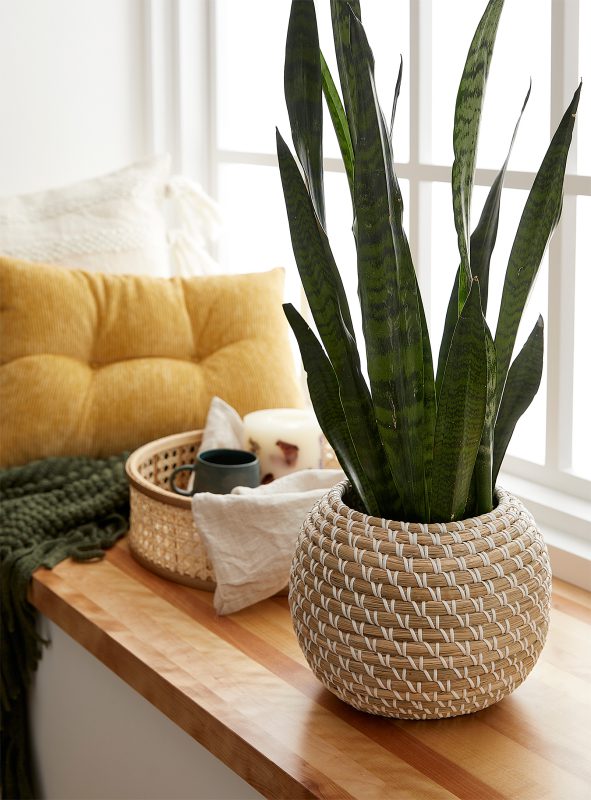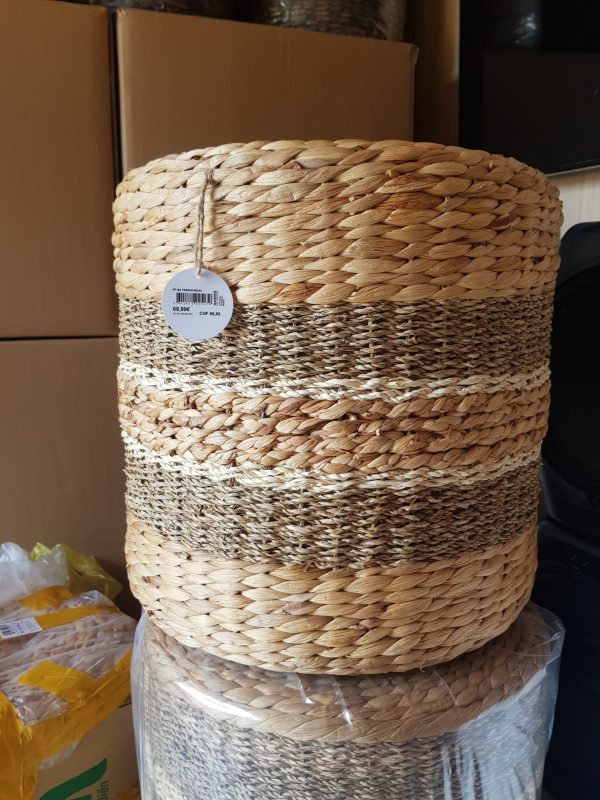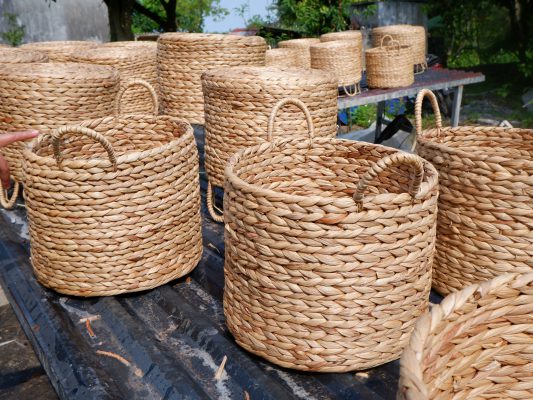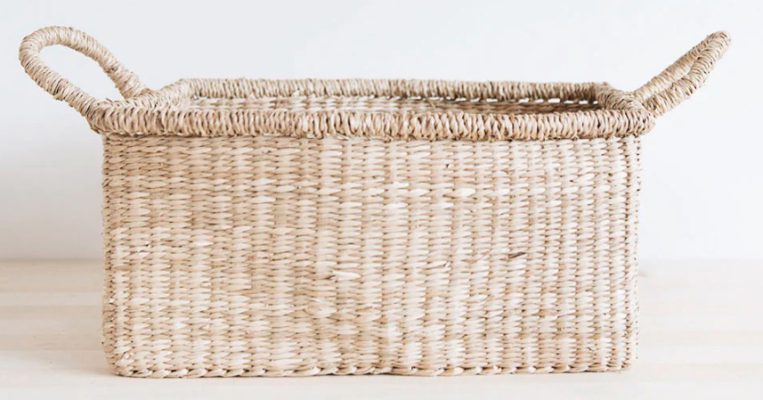No products in the cart.
Handicrafts are still on the rise on e-commerce sites, especially Amazon. Large retailers consistently have lots of customers for their products, especially those from China and the US. They mostly import a sizable quantity of decorative items made from natural materials like seagrass and water hyacinth with the best quality from suppliers in Vietnam, India, Thailand, etc.
If you are a new seller or planning to become a new seller on Amazon, this guide will help you better understand the handicraft market, how to identify promising suppliers, and how to sell handicraft decorations on the platform.

1. Supplier selection criteria
Good suppliers are a key factor in the success of an Amazon seller. They are the ones who understand the market & the competition and are the key to bringing in more profits. With a trustful and beneficial, the seller will have a flourishing business journey. If there is a bad relationship, the seller index will be negatively reduced. You need to keep in mind that even one negative review will cause your business to lose money.
Cost is always an inevitable condition in finding new suppliers. As such, cost should be your primary reference when researching suppliers. But the cost is not the only concern, there are a few more factors to judge whether suppliers are reputable or not.
1.1. Experience working with Amazon Sellers
Sellers should choose suppliers who have experience working with Amazon sellers, as they will be able to help new sellers in accessing the Amazon market. What they can do, for example, is help you in understanding Amazon’s requirements, understanding consumer needs, which types sell well, market requirements, packaging, and quantity for the first and subsequent orders.
Therefore, new sellers can learn from experienced vendors about product listings, peak product promotions, and how to sell to attract a steady stream of customers.
Some suggested questions need to be answered when researching suppliers:
How long have they been in business?
How many clients do they service?
Do they have the appearance of trying to swiftly offload some undesirable inventory?
How do they pack and produce products to meet Amazon’s packaging and quality standards?
1.2. Suppliers’ capacity and MOQ
You should look for suppliers to help out with the orders you make on Amazon for the first time. Reputable suppliers will often support you in processing from the smallest of orders to test the market to larger orders when you’re more established.
In addition, those suppliers must be able to sustain monthly orders, especially during peak periods. The quantity for the first order may be low, so the seller needs to discuss this with the suppliers so that they can pre-fill.
Some suggested questions need to be answered when researching suppliers:
Will the suppliers be able to handle larger orders if you find a product that sells well?
If you are just getting started, are they OK with smaller orders?
Do they possess the internal resources necessary to offer you a specific resource?
Are the facilities and factories big enough?
Is the monthly capacity and maximum capacity satisfactory?
1.3. Suppliers’ flexibility
Another important criterion is that the supplier is flexible and willing to participate in negotiating your agreements. Choose suppliers that have a sales policy including different terms for different types of customers. Your specific requirements for shipping terms and order terms can be approved by the supplier. They must also allow for some flexibility to your own (if any) specific order requirements.
Maintaining active connections with your suppliers rather than placing undue demands on them should be a priority. This will encourage suppliers to work with sellers and accomplish business goals as a team. Choosing flexible suppliers will help the seller handle the seller’s request as quickly as possible. Some suggested questions need to be answered when researching suppliers:
Can your supplier agree to a quicker delivery schedule or technique?
What about the dates for invoicing and payments?
Do they accept price negotiations for larger orders?
How quickly do they respond to your requests?
Will you have multiple ways to get in contact with them if there are any issues?
1.4. Product quality
A shipment of poor quality products will use up a lot of the seller’s resources, including time, effort, and money, such as not enough products being delivered, products of low quality, or the wrong product being delivered, … which will in turn decrease the account’s credibility.
Sellers should ask suppliers for inspection standards such as ISO 2859-1 at least for the first orders. To check if a supplier’s products fulfill quality standards, sellers can request product samples. Suppliers should have regular reports, especially with first orders. Those reports should include production samples, inline reports after 10% completion, and final reports after 90% completion. The purpose is to keep a close eye on the product’s progress, when anything goes wrong, report it and make adjustments immediately.
Some suggested questions need to be answered when researching suppliers:
Do they show any inspection standards similar to ISO 2859-1?
Do they show evidence of understanding the shipment quality levels?
Can they commit to the current product’s quality?
Do they accept refunds for defective products?
1.5. Responsiveness and customer support
This is an important element while evaluating a supplier. A good provider will be open to working with the customer and finding a time that works for both sides. Additionally, their responses via email and telephone must be comprehensive, specific, and thorough so that customers can understand their inquiries. Additionally, they should be prepared to get in touch with the client and offer a solution if there is any delay.
They should have staff members available to support clients with design, sampling, product development, and logistics aspects. They should also be ready to assist in urgent situations.
Some suggested questions need to be answered when researching suppliers:
Do they appear more dedicated to fast transactions or top-notch service?
Is the way they communicate fluently?
Are they proficient in spoken and written English?
If there are any delays or adjustments, do they make an effort to contact you?
Are there ways for both parties to communicate effectively?
2. Selling Vietnamese handicraft items on Amazon – Things of note
2.1 Handicraft products – a definition
Handicraft products – as the name suggests – include various items (from baskets, storage boxes, and tabletops to wall and mirror decorations) made by hand from natural materials. Along with other utilities, most handicraft products are purchased with the primary purpose of home decoration due to their unique aesthetics and simplicity in maintenance.

In Vietnam, handicrafts are typically made from seagrass, water hyacinth, corn husks, or palm leaves, grown and processed locally. They are rarely machine-made but often handwoven by skilled artisans in great amounts. Thanks to their premium quality and competitive prices, a large percentage of handicraft sellers on Amazon source their products straight from Vietnam.
2.2 Things to consider
The primary thing you need to consider when planning to sell Vietnamese handicrafts on Amazon is what to sell, and on which marketplace. Naturally, customers from different markets will have preferences for different items. Here are a few trends our Amazon handicraft seller partners have noticed from their customers in recent years:
– US consumers have been generally in favor of water hyacinth items – especially baskets and trays
– Japanese customers are big fans of small, compact storage baskets made from seagrass and water hyacinth. Poufs & ottomans are also in hot demand in the Japanese market.
– Europe has long been and will continue to be a prominent marketplace for all kinds of handicraft home decor
– In addition, handcrafted wall hangings have recently become one of the customers’ all-time favorites for home decoration around the world.
You should do thorough research on your desired market, and figure out a plan to penetrate it.
LOGISTICS ASPECT
TRANSIT TIME of product loads is the primary factor to take into account, given the huge geographical difference. For example, with established suppliers, there is typically a 60-day production time, although this can be flexible with each supplier. A product transit from Vietnam to US warehouses by sea freight should also take another 30 days, making it a rough 3-month period (otherwise known as lead time) between placing your order and receiving the products in the US.
Plan & manage your inventory carefully based on customer demands at different times of the year. Identify peak seasons for your products to stockpile ahead, as running dry and having to reject orders can seriously hurt your product ratings along with any future prospects.
TRANSIT PRICE is also a notable factor when sourcing products across the world. Do the research and consult with your suppliers carefully to figure out the most cost-effective way to transport products in bulk from Vietnam (whether by air or sea) to Amazon-ready warehouses.
For instance, speaking from our experience, large volume full-container loads are generally the most cost-effective compared to parcels or less-than-container shipments. You should plan carefully so that your shipment is both cost-optimized and able to ship enough products to last until the next arrival. There are also some integrated tools to assist you in managing surplus inventories on Amazon – utilize them to straighten your management process.
Finally, having a thorough understanding of your fellow sellers (or in this case – “competitors”) on Amazon will bring you far in your venture. It’s quite easy to notice that most handicraft sellers on Amazon are located in the US or China while having their products sourced from Vietnam and East Asia. Figure out their sales channels, what products and categories they cover, their pricing, and what contributes to their competitive edge is key to optimizing your own.
3. 8 Steps to selling Vietnamese handicrafts on Amazon
Assuming you’ve already created your Amazon Seller account and are ready to sell, here are 8 comprehensive, down-to-earth steps for selling your first handicraft items on Amazon:
3.1. Market Analysis & choosing products
One of the best strategies to apply when researching an Amazon marketplace is to reference your competitors’ listings. You should take notice of your future competitors, what products and categories they have, their best sellers, and monthly revenues. There are various third-party plugins and tools you can use to compile and analyze this information. Some common tools our Amazon Seller partners often use include JungleScout, MarketScout, or Helium 10.
Next, pay attention to customer feedback through Amazon’s ranking and review system: how products are ranked and rated, what consumers are complimenting them on, what can be improved,…. Too often we see a basket or placemat with great design and a decent price gets a plethora of 1-star reviews just because it is “a bit bent” or “wet and moldy” – little things that can be easily avoided.
Research your future competitors and customers well, and detect market gaps that your product can penetrate and improve upon.
After careful analysis of your Amazon marketplace, decide on the products you wish to launch. A common “rookie mistake” story our Amazon seller partners often share with us: most were choosing their first products to sell based on “gut feelings” – their favorite design, a model they think “looks unique”,… rather than based on what the market demands, and were left with a “perfect product” in their eyes, but not even close to enough sales to justify their Amazon business.
In addition, the products for Amazon are recommended to optimize shipping costs, which are products that can be overlapped. Click this link to view products for Amazon Sellers by Greenvibe: Recommend products for Amazon Sellers
The only way to have a shot at success is to sell based on speculations of the market, and the only way to test your speculations is to run actual sales on Amazon.
3.2. Find a supplier & make a production plan
After having an idea of what products to sell on Amazon, you should now find one or multiple suppliers who can respond to your product requirements, with our long list of criteria above. As this product is one of your first to test the market, you likely would have a low order quantity. Make sure to find a supplier who allows a low first-order MOQ, and has experience working with Amazon sellers.
You should at this point have a detailed scenario for your products, things such as cost of goods sold, logistics fees, estimated time of arrival, estimated revenue, and profits, …. Remember to implement the information you’ve researched to help your products gain a competitive edge. Afterward, consult with your suppliers, make any changes and come to an agreement on your production plan.
3.3. Begin the production process
Your suppliers should now begin the production process. Your job is to follow the production status closely, from reviewing samples to updating progression. It’s crucial that you’re always aware of your order’s progression – what stage of the production process your supplier’s in. Have samples sent to you and reviewed regularly, and notify your suppliers immediately should any faulty problems arise.
After the products arrive at your designated warehouse, prepare to have them moved to Amazon fulfillment centers (FBA) or your personal warehouse (FBM) to be Amazon shipment-ready.
3.4. Prepare your products on Amazon
You should now also be preparing your products on the front end – crafting compelling product listings on Amazon is another pivotal step for your handicrafts to stand out among literally thousands of competitors. Take product photo shoots from your samples and write interesting descriptions to be listed on Amazon, and prepare support materials for Amazon customers.
*Having your own registered handicraft brand on Amazon would do wonders for your business, as your product won’t be registered as “generic” and have its own product listing. You will also get access to various additional listing features such as product videos, personal storefronts and advertising opportunities. Work with an attorney to have a brand registered in the country you want to sell in, and let Amazon Brand Registry start the verification process.
3.5. Running Amazon PPC campaigns
There are a few tips for running more effective PPC campaigns.
As mentioned before, you need to optimize your content and listing. To enhance click-through rates and conversion opportunities, you must create a high-quality listing with relevant product photos, compelling writing, and other elements. It will cost you a lot if the listing is not optimized because it won’t draw in customers. Nobody notices a shady, unattractive, and bland product to purchase.
Undoubtedly, a lot of people begin an advertising campaign without a specific objective in mind. Their willingness to spend on advertising and the amount they anticipate recovering from that budget is not calculated or fully understood. Therefore, paying attention to the budget and expense control should follow next.
Consider ACoS, the portion of income that is spent on advertising expenses. This figure can be obtained by dividing your entire advertising expenditure by the volume of sales. Sales are included in the calculation of advertising revenue. If you are launching a new product, ACoS can be the breakeven point. This means the ACoS percentage will be equal to your profit.
You must place a bid for each keyword in PPC. Look for profitable keywords and raise your bids for those that convert well. You should regularly check the keywords that Amazon displays in your listings to see which keywords are searched for most often, and which keywords are most effective at generating sales by looking at keyword lists.

Once you have established a set of high-converting keywords, now all you need to do is get rid of the non-converting keywords to avoid wasting your money. You can put these words in negative user keywords, and Amazon will make sure your ad doesn’t appear in these searches. This will narrow down the search funnel to ensure your ad is shown only to relevant searches.
Your daily budget needs to be constantly under revieOvervieww. If you have a sizable budget for Amazon PPC, you should set a budget for each hour of the day. On the other hand, you can fully implement your entire budget whenever you decide that time is best for the day. Customers of Amazon typically shop late at night. Thus, you should manage your finances to prevent missing out on possibilities. Setting a bigger daily budget for a shorter amount of time will help you get around this and keep it under control. You can also login in the middle of the day to reset your daily budget after setting it to $0 in the morning. These sales are aimed toward afternoon and evening consumers.
You can create an ad campaign whenever you want. However, you should choose the right time, the opportunity to promote your business will go further and faster. An Amazon PPC campaign is necessary to attract customers more quickly if you are releasing a new product. But be aware that even if you spent money promoting a post to boost it to the top of search results, your clients won’t be interested in your listing if the price, ratings, and listing aren’t optimized. You can also launch a sales promotion campaign for your promotion or develop an advertising campaign for a product with low sales but strong potential.
Each Amazon PPC campaign presents a significant business opportunity. With optimized lists, keywords, and perfectly controlled budgets, Amazon PPC will deliver a high return on investment. Thanks to PPC, your orders can reach more customers, help improve products and take advantage of keywords. That will help businesses run the long haul on Amazon.
3.6. Optimizing costs
Optimizing costs on Amazon is also important if you are a new seller.
Shipping costs will depend on the product. If your products can be stacked, it will help save packing space and product volume. Finding a cheap agent is also a good idea to save on shipping and packing costs.
Advertising costs can also be optimized. Optimize keywords, including popular keywords and negative keywords to show up at the top. Besides, based on customers’ buying behavior at night, can reduce and save PPC’s daily budget.
Regularly checking the items is advised. There are numerous products that, when ordered in large quantities, will go out of stock; you must restock them to maintain stable sales and a foundation of devoted customers. You must put more effort into making things with no potential more appealing. However, if you invested too much in it and received nothing in return, you might want to think about deleting it from your sales directory.
You should also concentrate on regularly updating the store with fresh merchandise. These items are popular because of their novelty. These products could improve sales and become best sellers if an effective marketing campaign is launched.
You must improve your promotion and put more emphasis on the quality of your best-selling products. As a result, the best-selling item receives many favorable reviews and appears on the first pages of search results for customers. The product will continue to be popular in the market as long as there are positive reviews.
3.7. Build a good relationship with suppliers
A few tips for maintaining an effective supplier relationship.
Stay proactive: Addressing issues, challenges, and problems, as they happen, reduces the severity of contingencies. Discussion and action will soon build mutual trust.
Communicate Regularly: Communication creates understanding and sharing. That helps you avoid unnecessary disagreements and misunderstandings. Communication is a two-way street to building a strong and effective relationship.
Be punctual: Pay expenses on time, comply with sales contracts, and be clear in everything. That will give you credibility and will help you and your supplier work together in the long run.
Share information about the business: Regularly share information about personnel, products, and promotions with suppliers. That will let them see more opportunities for them to offer additional helping services or products.
Incentivize Value Offer: Strong business relationships often occur when both parties can provide value. Instead of just looking at how suppliers can help you, consider the value you bring to them. In some cases, simply listening to and offering advice to suppliers is key to strengthening their relationship.
Consider long-term opportunities: When was the last time you scheduled a meeting with a leading supplier to discuss a partnership? During the discussion, see if both sides can help each other.
Get to know your supplier’s business: In a relationship with suppliers, when you understand their business processes, you gain a better understanding of their company values. and the challenges they face. So you can understand and adjust your expectations when there are delays in delivery.
Good relationships with suppliers are an extremely important tool for the success of the business. Your delivery needs will be well met if you are in the same location as them. A good relationship makes negotiations easier, you have a better chance of making better deals.
4. Conclusion
This is a detailed guide on how to sell Vietnamese handicrafts on Amazon. The steps are all very important, and if you follow them correctly, your account will attract more customers and sell more orders on Amazon.
Greenvibe is a supplier that has a lot of experience in supporting Amazon sellers. Contact us if you are interested in finding knowledgeable suppliers on Amazon and creating a long-term partnership together.







